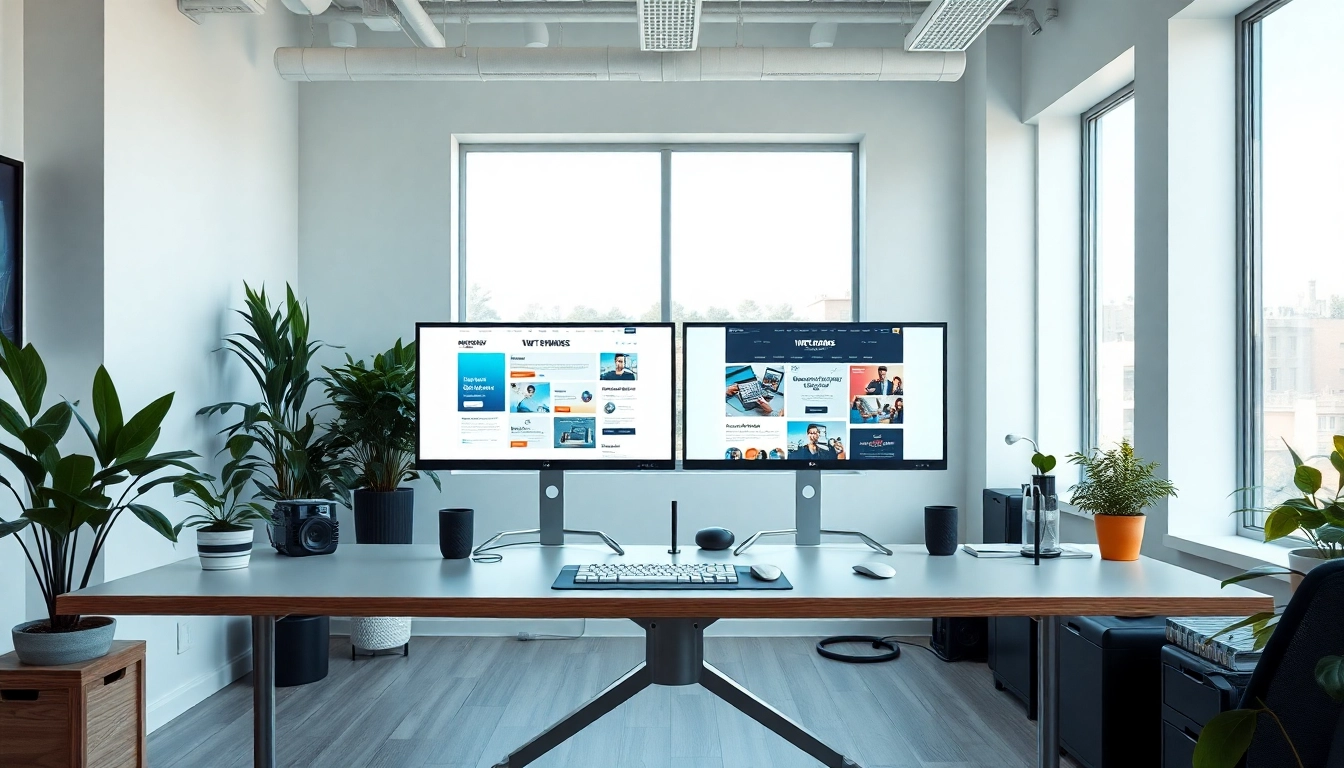Understanding the Basics of Web Design
Introduction to web design principles
Web design is a multifaceted field that combines creativity and technology to create visually appealing and user-friendly websites. A strong foundation in web design principles is crucial for aspiring designers. The main principles include balance, contrast, emphasis, movement, white space, proportion, hierarchy, repetition, and rhythm. These principles guide designers in creating layouts that attract users and guide them seamlessly through the content.
In essence, web design is not just about aesthetics but also involves functionality and user interaction. A well-designed website improves the user experience while fulfilling organizational objectives. For those looking to enhance their comprehension and execution of this craft, exploring resources on web design can provide valuable insights.
Key components of effective web design
Effective web design is a combination of several key components. Firstly, layout plays a crucial role in determining how elements are placed and interact on a webpage. A well-structured layout enhances readability and organizes information clearly. Secondly, color scheme significantly impacts user emotions and sets the tone for the website. Choosing complementary colors can evoke the desired reaction from users and improve overall aesthetics.
Typography, or the art of arranging type, is another essential component. The choice of fonts affects readability and user perception. Designers should strive for a balance between style and functionality. Additionally, images and graphics can convey information powerfully; thus, selecting high-quality visuals that align with the site’s purpose is vital. Lastly, responsiveness ensures that a website performs optimally across various devices, contributing to a cohesive user experience.
Understanding user experience in web design
User experience (UX) design focuses on enhancing user satisfaction through improved usability and interaction with a website. Understanding the target audience is critical for creating effective web design. This involves researching user needs, behaviors, and preferences.
Moreover, intuitive navigation is integral to UX. Users should be able to find what they seek quickly without confusion. Implementing clear calls to action (CTAs) guides users toward desired actions, such as subscribing to a newsletter or making a purchase. A website’s load time can also significantly impact the user experience; if a page takes too long to load, users may abandon it altogether.
Regularly gathering user feedback is essential as well, allowing designers to iterate and improve based on actual user interactions. By continuously testing and adjusting design elements, a website can evolve to better meet the needs of its audience.
Essential Tools and Technologies for Web Design
Top software for web design
The landscape of web design software is broad and diverse, catering to various aspects of the design process. Graphic design tools, such as Adobe Photoshop and Illustrator, are staples for creating visuals that can be integrated into websites. These programs allow for high-quality graphic creation and manipulation, essential for modern web aesthetics.
Wireframing and prototyping tools like Figma, Sketch, and Adobe XD help designers visualize their ideas and create user interfaces before diving into coding. These platforms offer collaboration features that allow teams to share designs and receive feedback in real time, streamlining the design process.
For developers, code editors such as Visual Studio Code or Sublime Text provide environments to write HTML, CSS, and JavaScript efficiently. These applications often include features like syntax highlighting and error tracking, making coding smoother and more intuitive. Furthermore, version control systems like Git allow multiple users to track and manage changes to project files, which is particularly useful for larger teams.
Learning web design coding languages
Knowledge of coding languages is foundational to modern web design. HTML (Hypertext Markup Language) is the backbone of web content, providing the structure of a webpage. It’s essential for any designer to understand how to organize content using elements such as headings, paragraphs, lists, and links.
CSS (Cascading Style Sheets) is equally important, allowing designers to apply styles and create visually engaging experiences. CSS dictates everything from typography to colors and layout arrangements. Advanced techniques, like CSS Grid and Flexbox, enable responsive designs that adapt seamlessly to different screen sizes.
JavaScript brings interactivity to web pages, allowing for dynamic content that enhances user engagement. Understanding the fundamentals of this programming language is crucial for anyone looking to create a website with rich user experiences. Combining these three languages provides the tools necessary for successful web design, opening up a world of creative possibilities.
Utilizing templates and design frameworks
While custom web design can be rewarding, pre-designed templates and frameworks offer substantial advantages, particularly for beginners or those working within tight deadlines. Templates help jumpstart the design process by providing a ready-made layout that can be customized according to specific needs.
Design frameworks such as Bootstrap or Foundation offer pre-defined components that help developers create responsive designs quickly and consistently. These frameworks come with grid systems, button styles, and navigation menus, allowing for efficient design without starting from scratch.
Using templates and frameworks can save time and ensure best practices are followed, which is particularly beneficial when working on multiple projects. However, designers should balance reliance on templates with the need for uniqueness to avoid a cookie-cutter appearance.
Web Design Best Practices
Creating responsive web design
With the increasing use of mobile devices, creating a responsive web design is essential. Responsive design ensures that a website adapts its layout and content to fit various screen sizes and orientations, providing an optimal viewing experience no matter the device.
To achieve this, CSS media queries are commonly used, allowing designers to tailor styles based on the device’s characteristics. Additionally, fluid grids and flexible images help ensure that layout elements resize appropriately without losing quality or structure.
Testing the website across different devices and browsers is crucial to ensure a consistent experience. It is advisable to prioritize mobile-first design, where the mobile interface is designed first and then scaled up for larger screens, accommodating the growing number of mobile users.
Importance of accessibility in web design
Accessibility in web design refers to creating websites that can be used by everyone, including individuals with disabilities. It is not only a legal obligation in many regions but also a moral imperative to ensure inclusivity. Accessible design involves considering various user needs, such as those with visual impairments who may rely on screen readers.
To promote accessibility, designers should use semantic HTML, ensuring that elements are properly marked up. Alt text for images, proper heading hierarchy, and keyboard navigability are fundamental components of accessible web design. Additionally, designers should also ensure adequate color contrast and consider users’ cognitive disabilities when organizing content.
Regular testing with users who have disabilities can provide invaluable insights into the accessibility of a website, enabling designers to make informed adjustments and enhance usability for all visitors.
Ensuring SEO-friendly web design
Search engine optimization (SEO) is vital for ensuring that a website is discoverable by search engines, driving organic traffic. Web design plays a significant role in SEO, as search engine algorithms evaluate site structure, content quality, and user experience.
Key strategies include using clean, semantic HTML to help search engines understand the content hierarchy. Designers should also pay attention to page speed, as slow-loading pages can lead to higher bounce rates and lower rankings. Including meta tags, alt texts for images, and descriptive URLs can further enhance a site’s SEO performance.
Additionally, integrating a responsive design contributes positively to SEO. Search engines prioritize mobile-friendly websites, and having a unified URL for both desktop and mobile versions can streamline indexing and improve visibility in search results.
Advanced Techniques in Web Design
Integrating animations and interactivity
Integrating animations and interactive elements can enhance user experience by making a website more engaging and dynamic. Subtle animations, such as hover effects, loading animations, and transitions, can draw attention to specific content and create a more interactive experience. They can guide users’ actions and improve overall journey through the website.
Using CSS animations and JavaScript frameworks like jQuery can simplify the creation of these effects. However, it’s crucial to maintain a balance—while animations can elevate a design, they should not overwhelm users or detract from usability.
Moreover, interactive elements like quizzes, calculators, or dynamic forms engage users further, prompting them to spend more time on the site and enhancing conversion chances. By monitoring user interactions with these features, designers can gain insights into user preferences and behaviors.
Using color theory effectively in web design
Color theory plays a pivotal role in web design, influencing user emotions and perceptions. Different colors can evoke various feelings—warm tones often communicate energy and excitement, while cool tones tend to convey calmness and professionalism. Understanding these associations can help designers make informed choices that align with the website’s objectives.
Utilizing complementary color schemes creates a visually appealing contrast, whereas analogous schemes produce a harmonious look. Consistent color palettes help in establishing brand identity and recognition. Accessibility must also be considered; ensuring color contrasts meet standards allows users with visual impairments to navigate the site effectively.
Designing with color psychology in mind aids in creating a desired atmosphere, whether it reflects urgency, trust, or creativity. Incorporating color strategically throughout the design enhances visual hierarchy and guides users’ eyes to the most critical elements on the page.
Harnessing user feedback for design improvement
To ensure a website meets the evolving needs and expectations of users, designers must actively seek and incorporate user feedback. Surveys, usability testing, and social listening provide valuable insights that guide design refinement. Gathering qualitative and quantitative data helps identify strengths and pain points within the user experience.
Utilizing analytics tools allows designers to track user behaviors, such as navigation patterns and conversion rates, providing data-driven insights. A/B testing different design elements can reveal which versions resonate more strongly with users, informing future design iterations.
Foster an ongoing dialogue with users by encouraging interaction through comments or feedback forms. By demonstrating that user opinions are valued and considered, designers build loyalty and enhance user satisfaction. Continuous improvement through feedback integration is integral to maintaining an effective and successful website.
Measuring Success in Web Design Projects
Key performance indicators for web design
Success in web design can be quantified through various key performance indicators (KPIs). These metrics help designers assess how well a website meets its objectives and determines areas for enhancement. Common KPIs include page load time, bounce rate, conversion rate, and user engagement metrics. Each of these indicators provides valuable data reflecting user experiences and interactions with the website.
Establishing KPIs early in the design process allows teams to align their strategies with specific goals. For instance, if the primary objective is to boost conversions, focusing on metrics related to user pathways and exit rates becomes critical. Regularly analyzing performance data helps teams pivot quickly and refine their tactics to optimize user experience and site effectiveness.
Analyzing user behavior post-launch
Post-launch analysis is vital for understanding user behaviors and interactions on a website. Utilizing tools like Google Analytics enables teams to monitor traffic sources, user demographics, and behavioral patterns. Tracking how users navigate through a site provides insights into which areas are performing well and which require improvement.
Heatmaps can further enhance understanding of user behavior by visually depicting where users click or scroll. This information can help identify areas of interest or confusion, guiding future design decisions. Understanding patterns such as the time spent on different pages or abandonment points in conversion funnels informs redesign strategies.
Continuous improvement strategies in web design
Continuous improvement in web design is essential to keep pace with evolving technologies and user expectations. Employing iterative design processes allows for regular updates and enhancements. Small, incremental changes can lead to significant overall improvements while minimizing disruption to the user experience.
Implementing regular audits of website performance, content relevancy, and user feedback ensures that the site remains current and valuable to its audience. Additionally, staying informed about emerging design trends and technologies enables designers to incorporate innovative features that enhance user engagement.
Lastly, fostering a culture of collaboration within design teams encourages sharing fresh ideas and perspectives. Working in agile sprints can enhance flexibility and responsiveness to user needs, creating a dynamic approach to web design that benefits teams and users alike.















Leave a Reply